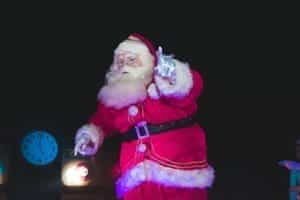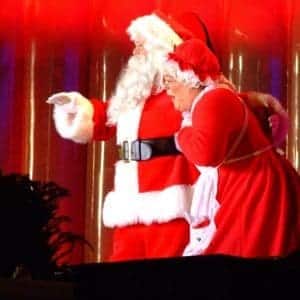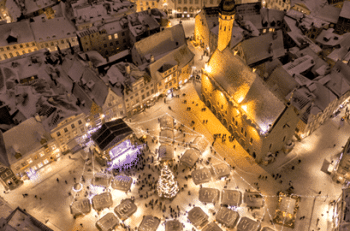He knows when you’ve been good and has access to your home without a key – but how much do you know about Santa Claus?

Santa Claus – do we really know who he is?
Santa is one of the modern world’s most recognisable figures and various versions of him are celebrated around the world.
There are some noticeable differences depending on where you are, for example, Santa Claus in the Netherlands is known as Sinterklaas and dresses like a bishop; in other countries, he wears a blue outfit and in others, he is a non-white man.
Santa is also known by various names including St Nick and Kris Kringle, Father Christmas and Grandfather Frost. In China, Santa is known as Shengdan Laoren.
So, let’s take a look at what you might and probably don’t know about Santa Claus.
Santa Claus is not a fictional character!
That’s not just us saying that. Did you know that Santa hasn’t been listed in the Forbes most rich list of fictional characters since 2006? That’s because too many angry readers wrote to the magazine insisting that Santa was real.
At the time, Forbes explained: “We took into account physical evidence, such as milk and cookies being devoured and toys delivered, and we felt it was safer to remove him from the list.”
That’s good enough for us!
Santa has always worn a red and white suit
We all have a fixed image of what Santa Claus looks like, but he hasn’t always worn a red and white suit.
That didn’t begin until 1931 when Coca-Cola used a version of Santa for their advertising wearing their trademark colours. And he has looked that way ever since – a great look or a commercial tie-up masterstroke? You decide.
Before the Coke adverts, Santa was seen in outfits of various colours including brown, green and blue – especially in the UK.
His sleigh is the world’s fastest vehicle (probably)
Considering that Santa’s entire business model is to make and then give away toys to children around the world without making any profit is incredible.
However, what is more impressive is that he manages to visit around 2.1 billion children in one night – that’s an average of 2.5 children per household without forgetting anyone.
Plus, taking into account the number of homes means Santa will make around 142 million stops and has 31 hours to do it in, thanks to the Christmas Eve time zone differences.
Boffins have worked out that to get to every home, unload his sack of various presents means that the sleigh he uses must travel at 1,800 miles per second.
That’s way faster than the fastest man-made object which is currently the Juno spacecraft built by Nasa which can only reach a paltry 40 miles per second.
For those who really do question the physics, then children need to be told that Prof Brian Cox has explained that Einstein’s special theory of relativity also helps explains Santa’s prolific present delivering schedule in the time he has. Essentially, the theory states that the faster you travel to the speed of light, then the more distance shrinks.
And hey presto, a sound explanation for doubting children.
How Santa gets into your home
 Traditionally, Santa enters your home via the chimney but with so many modern houses being built without them, he now uses a special key. Apparently.
Traditionally, Santa enters your home via the chimney but with so many modern houses being built without them, he now uses a special key. Apparently.
However, for many years people believed Santa used the window for delivering presents until a better solution was found using the chimney – which is mainly down to a short story written by Washington Irving in 1812.
This is probably worth remembering for those obscure pub quizzes because most people will say that the legend of using chimneys began with the story, ‘Twas the Night Before Christmas’. It wasn’t.
(Though this is also worth noting as an obscure quiz question because no one knows who wrote the story ‘Twas the Night Before Christmas’ since it was sent anonymously in 1812 to a New York newspaper.)
Where do the letters addressed to Santa go?
Obviously, every letter that is written by a child to Santa with a list of Christmas presents will be delivered to his home at the North Pole.
If you’d like to know the correct address for writing to Santa (from the UK), then it is:
Santa/Father Christmas,
Santa’s Grotto,
Reindeerland,
XM4 5HQ.
(Don’t forget to add an unused stamp in the envelope!)
(And your name and address so Santa can reply!).
The last postal date for Santa for those in the UK is usually in the first week of December so he can reply in time. As if Santa hasn’t got enough to do already!
Who sends the most letters to Santa?
One interesting factoid about writing to Santa is that the country sending the most letters every year is not the UK or even the US. Instead, the statistics reveal that the number one country writing to Santa every year is France. Apparently, French children send around 1.7 million letters every year, compared to 1.3 million from Canada and one million from the US. Children in the UK send around 800,000 letters. (Mexico might make the list if they didn’t send their letters to Santa attached to helium balloons …).
Santa has gone modern
Did you know you can call Santa from a mobile phone to help in the Christmas build-up of excitement? Children will hear Santa’s voice and a mobile app will see them receive a phone call from Santa himself while he’s at the North Pole.
Other apps let you text Santa, while others let you leave a voicemail and schedule a call so Santa will ring back at the perfect time. As is to be expected, children can even video call Santa in his grotto so they can speak face-to-face with Father Christmas.
Where does Santa Claus live exactly?
While we’ve seen that Santa’s grotto is in Reindeerland, we should appreciate that it must be close to the North Pole because that’s what tradition tells us.
However, there is a town called North Pole in Alaska which tried to claim that Santa lived there at one time. That move didn’t go down too well with the Finnish inhabitants of its most northern province, a town called Rovaniemi who insist that Santa lives there. There is even a Santa Claus Village where Santa is available every day of the year for meeting children and not-so-young-children who still believe in Santa.
Santa married late
 Considering how long Santa Claus has been in popular culture, since the 1700s, he was always a bachelor until someone asked whether he would settle down.
Considering how long Santa Claus has been in popular culture, since the 1700s, he was always a bachelor until someone asked whether he would settle down.
He didn’t have a wife until 1849 when Mrs Claus appeared in a short story called a ‘Christmas Legend’ written by James Rees in Philadelphia.
In the story, Mrs Claus asked Santa why he has to have all the ‘glory of the joyous Christmas story’ and she wanted a slice of the action.
How many presents does Santa deliver?
Considering how many children there are in the world, and we have already looked at how quickly Santa’s sleigh must travel, then there’s an astonishing need to carry at least 400,000 tonnes of toys and presents for his mammoth shift.
What’s more astonishing is that it only uses nine reindeer to carry out this present giving blitz when scientists have calculated that he would need at least 360,000 magical reindeer to carry so many tonnes of presents. But what do they know?!
The reason why Santa is not slim
 Imagine travelling the world and in millions of homes you have to consume treats left by children living there. If we take into account that an average of two cookies are left out for Santa means he must consume around 33,000 tonnes of sugar and 150,000 tonnes of fat. That equates to an incredible 374 billion calories so it’s a good job he’s so busy for one evening because he would otherwise have to run for nearly 109,000 years to shed himself of those calories.
Imagine travelling the world and in millions of homes you have to consume treats left by children living there. If we take into account that an average of two cookies are left out for Santa means he must consume around 33,000 tonnes of sugar and 150,000 tonnes of fat. That equates to an incredible 374 billion calories so it’s a good job he’s so busy for one evening because he would otherwise have to run for nearly 109,000 years to shed himself of those calories.
Thankfully for Santa, in Britain and Australia he might be left mince pies or the choice of sherry or beer instead of cookies. Perhaps not so thankfully, in Norway and Sweden, children there will leave out rice porridge and in Ireland young children will pour milk or a Guinness and leave mince pies or nibbles of Christmas pudding.
Other things you may not know about Santa Claus
Did you know that Santa has a pilot’s licence? He was handed one by the US government in 1927, so he’s perfectly legal to fly in airspace.
Santa and Mrs Claus also have ePassports which were issued by the Canadian government in 2013.
And Santa has his own postcode in Canada – the memorable (and quite brilliant) ‘HOH HOH’.
You can learn to be Father Christmas in the UK at the Ministry of Fun Santa School which started in 1999.
Children can track Santa’s progress on Christmas Eve using Norad’s famous Santa tracker. (If you are really worried about Santa’s progress you can call a special helpline (this is serious) for an update: 00-1-719-556-5211. (In reality, this will see one of the 157 volunteers at Peterson Air Force Base in Colorado Springs answering your call!)).
Even though Santa’s reindeer all have male names – they might actually be female since male antlers fall off before December.
Santa has more than 2,000 churches dedicated to him in Germany and France which makes him the most popular non-Biblical saint. There are 400 churches in England with his name.
Santa Claus’ origins began with stories of St Nicholas, who was popular among Dutch people who called him as ‘Sinter Klaas’ and the English pronunciation is Santa Claus – the first recorded use of this name in English was in America in 1773.




